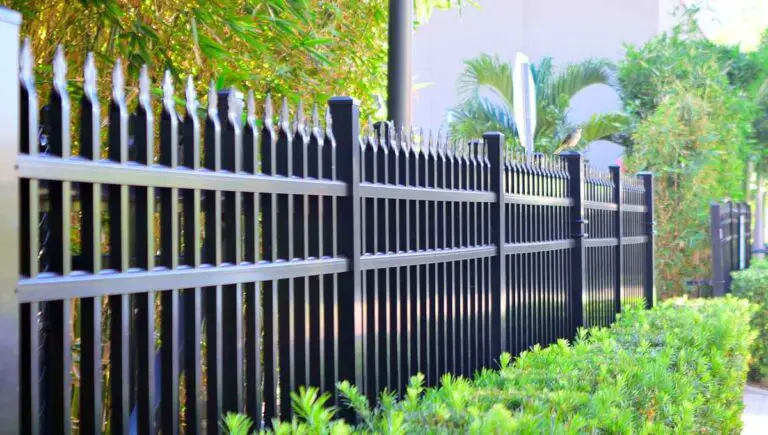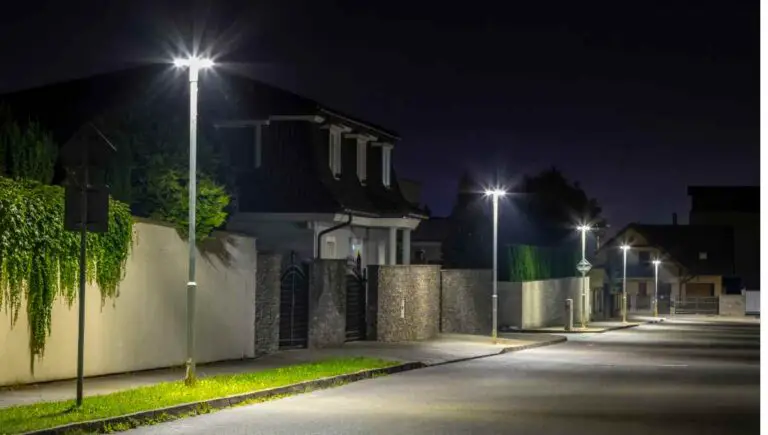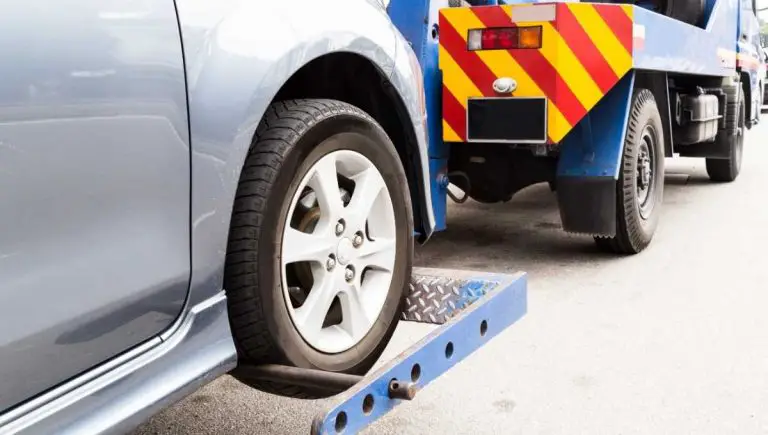Do I Need A Fence Around My Hot Tub? (Laws & Requirements)

If you’re considering installing a hot tub in your yard, you’re probably wondering if you need a fence around your hot tub. Unfortunately, this matter can be very confusing, mainly because the rules vary per state, and some specifications may or may not apply to your area.
Since Congress passed the Virginia Baker Act in 2008, most states require their citizens to install fences or covers around their pools, hot tubs, and spa pools. The reason for these measurements is to keep young children from drowning if they accidentally trespass and get curious about your hot tub.
Even though many states require you to install fences, some states just require covers. So stay tuned because we will cover whether you need fences around your hot tub, the codes of installation for each, and what types of fences are suitable for your needs.
This post contains affiliate links from Amazon and other stores. This means Yard Blogger may earn a commission if you make a purchase using any of our links. Please refer to our full affiliate disclosure policy for full details.
Here’s a Quick Pro Tip!
Fence laws vary by state, but all have one purpose in common. To protect the lives of young children and the elderly from the risk of drowning.
We think you may want to consider getting these for the sake of safety surrounding your new pool or hot tub:
1. Black Chain-Link Fence – It doesn’t only provide protection, but it also provides a good, aesthetically classy look. Feel free to get one today.
2. VEVOR Security Fence – A fence that will help you keep pool safety your top priority.
3. Outdoor/Indoor Inflatable Hot Tub – An inflatable hot tub offers a quick solution to your bathing needs. You can practice safety by putting it away whenever you’re not using it or simply putting a cover over it. The best part is that it’s less costly in the long run!
The Different Fence Laws
Before we begin on our journey to discover the types of fences we may need for our tubs, we need to discuss the different viewpoints of the law that may apply to your state.
So, let’s discuss the different fence laws below!
Do You Need a Fence Around a Hot Tub?
Most states will require you to install a fence around a hot tub due to safety concerns regarding children and older adults. Yet, even if your state doesn’t necessarily require it, it’s recommended because of its legal and aesthetical convenience.
Moreover, a fence around your hot tub can limit the liability you may have in your state if a trespasser gets hurt in your hot tub.
Although rare, it’s still something that can happen, and thus, a fence is a good indicator that someone should not be at said place.
Do You Have to Build a Fence Around a Hot Tub?
For children’s safety, some states will obligate you to build a fence around your hot tub. States that follow this rule are guided by the Virginia Baker Act, a bill that Congress passed in 2008 after a tragedy occurred.
Virginia Baker died after being entrapped inside the water due to a pool drain, so Congress passed the Act and named it after her.
Since then, many regulations have been applied in each state to protect unsupervised children’s lives.
According to this Act, the state fulfills the minimum law requirements if they pass regulations that explicitly establish the safety requirement of pools and public bathing spaces.
The main requirement for pools is a barrier that encloses the entrance to the pool and protective covers for main pool drains.
And it also requires pools to have alarms, doors, or gates, to reduce the chances of drowning incidents and the like.
What Is Code for Having a Fence Around a Hot Tub?
The codes for fences around hot tubs vary depending on the type of fence and its enclosure, and the general rule of thumb is to make sure that fences don’t allow children to climb, go through, or under them.
According to the US Consumer Product Safety Commission’s Safety Barrier Guidelines for Residential Pools, the fences should be at least four feet high, although higher fences are recommended.
The codes vary per type of fence. For example, a chain-link fence should not have a mesh opening larger than 1¾ inch. The same requirement applies to lattice-made fences.
Each regulation considers the average child’s height, weight, and size while also considering their capacity to climb or go through the fence.
So, installing a hot-tub fence according to these guidelines is imperative.
Do I Need a Fence Around My Hot Tub if My Yard Is Fenced In?
Most safety guidelines about pools require installing a fence around your hot tub, even if your yard is already fenced. Thus, building one is highly recommended for safety, even if your current state law has not made it mandatory.
While it’s highly recommended for hot tub owners to install a fence, not all state laws have that requirement.
Some states only require you to have an approved tub barrier that ensures the safety of the children of your household.
In truth, the fence around your yard is not considered a pool safety fence installation. So, relying on it only may lead you to huge fines for violating state laws that require it.
Fences may not be required in your case, but they’re still necessary. If something happens and an unattended child goes to an unprotected hot tub area, they may suffer serious harm.
So, it’s best to avoid it by building a fence around your tub.
What Are the Hot Tub Bylaws?
Hot tub bylaws require citizens to have building and planning permits before installing any pool. They will also specify the type of enclosure and how the installation must proceed. Each regulation is specific to each state and city.
Usually, hot tub bylaws are included within public pools and private pool ordinances, as well as spa pools (hot tubs qualify as spa pools).
Generally, they include pool requirements and the safety protocols surrounding them.
Normally, local cities and communities will have their own bylaws and pool requirements that usually follow state-federal law ordinances.
An example is the Texas safety requirements for pools that you can find here.
Another example includes the city of Tecumseh, Michigan, which has a whole FAQ document discussing the protocols needed for building a pool or hot tub in residential spaces.
It requires the residents of Tecsumeh to have a permit before building a hot tub or pool.
Additionally, they also must consult with inspectors to ensure that the pool or hot tub has proper enclosures. So, you can see now that these bylaws are very detailed.
Bylaws can vary by state and city, so it’s recommended to check the ones applicable to your area to avoid complications or legal proceedings.
Do Hot Tub Fence Laws Vary by State?
While hot tub fence laws aim to provide extra protection for children and the elderly, it varies by state. Some laws require fences, others only require pool covers, and others regulate the type and size of the fence that homeowners must install.
For example, Florida law requires its residents to have a hot tub cover and a fence. Additionally, it requires hot tub and pool owners to install fences that don’t allow children to climb over them.
On a side note, Seattle’s law dictates that chain-link fence mesh must not go beyond 2¾ inches in size. In California, the law states that gaps some fences may have cannot be larger than four inches in diameter.
Meanwhile, the general safety guidelines for pools expressed by the US Consumer Product Safety commission establish that fence mesh sizes shouldn’t go above 1¾ inches.
So, while state laws aim to follow a generalized version of these protocols, these minor details vary.
However, other states take a step further in safety protocols.
For example, Texas safety pool laws, which also apply to hot tubs, established that chain-link mesh fencing and diagonal fencing are forbidden as of January 1, 1994.
So, knowing that these details can vary per state, you should consult with your local pool building protocols and safety laws to have a good idea of what to do.
Are the Fence Laws the Same for Inground vs. Above Ground Hot Tubs?
Regarding safety requirements, the laws apply equally to in-ground and above-ground hot tubs. But, other regulations may apply depending on the depth of the hot tub and the height of the above-ground pool.
For example, most states establish that above-ground pools must have a fence if the pool walls don’t exceed four feet tall.
However, others establish that even if they do, they must still have a small fence around their deck. So, these details highly vary depending on the jurisdiction.
Generally, both of them are still counted as hot tubs, and most states apply the same protocols to both.
Yet, other states simply choose to exclude them from certain regulations while applying new ones. We recommend that you check your state laws for more information.
Do Inflatable Hot Tubs Need a Fence?
Inflatable hot tubs don’t need a fence around them since they’re removable, and you can put them away. However, if you want to keep them in your yard for a day or two, it’s good to empty them and cover them to avoid any dangerous situations.
Even if your inflatable hot tub doesn’t need a fence, you still have to ensure the safety of your loved ones by putting them away or covering them temporarily. Not doing so can be tragic and fatal.
How High Does a Fence Need to Be Around a Hot Tub?
Fences need to be around 48 inches high from the ground to be around the hot tub, but this may vary depending on your current state. Therefore, you should check your local state or city laws for more details.
Tecumseh law requires its residents to have around four-foot-tall fences, while Illinois law requires them to be at least 3.5 feet tall.
From this, we can learn that this height will vary depending on where you live, generally ranging from three to five feet tall or higher.
What Is an Approved Barrier for a Hot Tub?
While some refer to an approved barrier as the fence around a hot tub, others refer to it as the cover that hot tubs need to have as a safety protocol, according to some state ordinances. The definition of approved barriers for a hot tub varies by state.
Studying these matters is essential to get rid of the confusion that may arise from this concept. Most laws and regulations speak about the covers that are ASTM F 1346-approved.
American Society for Testing and Materials (ASTM) is a non-profit organization that opened in 1898 to regulate safety standards for construction and other similar areas.
In the case of pool building, they set the rules while keeping the safety of children in mind.
What Are the Hot Tub Regulations?
Hot tub regulations include the requirement for a fence or tub cover and their height, which should go above three feet tall. They also establish that pools must have drain covers to avoid further accidents.
Here are specific rulings that most hot tub regulations include:
- In most states, a fence or cover is required for all types of hot tubs. However, some may exclude in-ground or above-ground hot tubs, even though state laws still likely apply regarding security concerns.
- Generally, fences surrounding hot tubs or pools must not go below three feet tall. These measurements were formed thinking of the average size of a young child between the approximate ages of three to eight years old, so this specification is important.
- Voids and gaps that fences may have due to the nature of their design, generally, must not go below 1¾ inch in size. However, some states may differ and specify 2¾ inches or more, just like in California. The purpose of this ruling is to avoid having easy-to-climb fences.
- Other direct requirements regulate the width of the spaces between the fence pickets should be. For example, they shouldn’t be wide enough to let a child pass through the fence.
- Lastly, other specifications include the need for protective covers for drains, regulatory measures regarding electricity, and other protocols that speak about health suggestions, such as the one established by the CDC.
What Kind of Fence Do I Need for a Hot Tub?
For a hot tub, you need a fence that discourages uninvited guests from going through, under, or over them to reach the tub area since this is the general ruling from many state laws and ordinances. Likewise, you need to get something that also adds to your privacy.
A good example of the type of fence you’ll need is this stainless steel aluminum fence.
Since they barely have any spacings in the mesh, climbing them is very hard. And their best part is that their design complies with state protocols.
What Is the Best Enclosure for a Hot Tub?
Solid-installed fences are the best enclosure for a hot tub, even though“enclosures” can include hot tub gazebos. You can install one or both, depending on your preference. But, state law usually requires fences, so you should consider getting them.
There are many options to choose from, including vinyl fences and aluminum fences.
But, truth be told, while your fence needs to comply with the requirements established for your city, you also need to get something that provides protection and privacy.
Should Spa Pools Have Fences?
Now that you know the basics about fence laws that vary by state, it’s important to understand if they also apply to spa pools.
So, we’ll be discussing the laws surrounding spa pools and fencing below. Check it out!
Do Spa Pools Have to Be Fenced?
According to many state and city laws or protocols, spa pools must be fenced to avoid having young children drown accidentally. For the same reason, other state ordinances only require spa pools to have a cover.
Although we know spa requirements are tedious, the truth is that protecting your spa pool area is highly necessary. You don’t want uninvited people suffering accidents inside your property.
Since they wouldn’t necessarily know they’re trespassing, you could be legally liable for it.
Do I Need a Fence Around My Above Ground Spa?
Whether you need a fence or not will highly depend on the height of your above-ground spa pool. The rulings for above-ground spas vary by state and depend on whether the spa has a deck or a ladder.
Some states require you to have a fence around your above-ground spa pool if it doesn’t reach four feet tall.
However, since having a four feet tall above-ground spa serves as a barrier, it may only need to have a removable or lockable ladder.
However, if your above-ground pool has a deck, it should have a small fence that aids your family to prevent them from falling.
You can check pool safety protocols applicable to your area for more details.
Is a Fence Required for a Swim Spa?
Swim spas often require a fence because it’s mandatory by state or city law, but the measurements of that fence will vary depending on the specific regulations of your area. Generally, fences should go above 4 feet tall to comply with these laws.
Fencing is much more than just following the law and building protocols. It’s about considering everyone’s safety.
It’s common to hear that anything can happen in a second if proper safety measurements aren’t taken. So, you should consider getting a fence regardless of whether your state laws require it or not.
You might also enjoy our post on If You Can Put a Pool in Your Front Yard?
Other Hot Tub Requirements
Generally, the terms “hot tub” and “spa pools” are used interchangeably, so the laws apply equally to both. However, we must pay attention to other hot tub requirements. Let’s talk about them in this section.
Does My Hot Tub Need a Cover?
Hot tubs should have a protective cover in addition to or instead of a fence. Nevertheless, covers serve as a protective barrier for both safety concerns and maintenance benefits.
Because hot tub covers work to not only help protect non-invited children from falling inside the tub and potentially suffering harm, they also help maintain your tub’s hygiene and durability.
Essentially, it’s a win-win situation, so you should consider getting one.
Do You Need a Permit to Have a Hot Tub?
Permits vary depending on the type of hot tub you’re looking to build. However, you’ll likely need one. Building a hot tub requires structural changes in your yard, and it may also include electric changes and plumbing, which often require permits.
Pre-fabricated above-ground hot tubs or spa pools don’t necessarily need a building permit, but they may require you to check your local codes for electricity.
Meanwhile, in-ground pools require all types of permits. Each city has specific ordinances regarding its building codes.
If you’re looking to add new plumbing and electric fixtures, you’re likely to need a permit and require the assistance of an expert electrician that can guide you through the process.
How Far Away From My House Should a Hot Tub Be?
Your hot tub should be at least five to six feet away from your property’s line. Therefore, it’s good to assume that this is the amount of distance your tub should have from your house. At the very least, it’s the building requirement for most tubs.
Additionally, the National Electric Codes establish that your hot tub should be five feet away from any electrical fixture to reduce the chances of electrocution.
So, make sure your new tub is up to code before you try it out!
How High Should a Hot Tub Be Above a Deck?
A hot tub above a deck should be from 17 to 24 inches tall because it can provide you with more security and safety, besides a much-needed commodity. Although, this may differ depending on the contractor that installs it for you.
Some contractors may want to install it 14 to 17 inches tall, while others prefer 24 inches tall.
The point is that this heigh allows your family to have somewhere to sit if they want to take a break from bathing, besides other safety concerns.
How Much Access Do You Need Around a Hot Tub?
The type of accessibility that you need around a hot tub must allow you to not only get in and out of the pool but also leave space for maintenance purposes. You need 18 or 30 inches of space on each side of the tub to work on it properly.
It will be hard for you to access your tub if you have very little space, so you need to leave out enough space to fit yourself and other people simultaneously.
If you don’t, it’ll be harder for you to do basic things that come along with hot tubs, like cleaning.
Related Questions
How Do I Make My Hot Tub Area Private?
You can make your hot tub area private by installing a fence or a privacy screen panel that allows you to hide your space. Not only will it protect the hot tub area, but it will also give you the sensation of peace you’re looking for.
Fortunately, you can buy a privacy screen online. They come in different colors and offer different benefits.
And they can also come in the form of decorative privacy screen panels, with leaf decorations and everything. So, check them out!
How Can I Make My Hot Tub Look Better?
Many things that can make your hot tub look better include adding decorative plants around the tub, decorative privacy panels, and common accessories to make your tub area look comfortable and aesthetically pleasing.
You can get creative and place multiple plants around the tub area, natural or artificial. Make sure that their colors match the vibe you want.
Otherwise, the decoration may not be as aesthetic as you expected.
Additionally, you can install other accessories, like pool umbrellas and cup holders. And you can also install a gazebo for a more sophisticated look!
So, don’t be afraid to try new things. You can easily find most of these products online.
Final Thoughts
Even though your state laws may not require you to install a fence around your hot tub or pool, it’s better to be safe than sorry by considering getting one.
The truth is that fencing is not only about following state protocol but for saving other people’s lives.
And, you should pick a good fence that is durable and complies with the standard national codes for hot tub fences.
Since these codes were made while keeping in mind the average size of a young child, it’s only logical to want to follow them to the letter.













